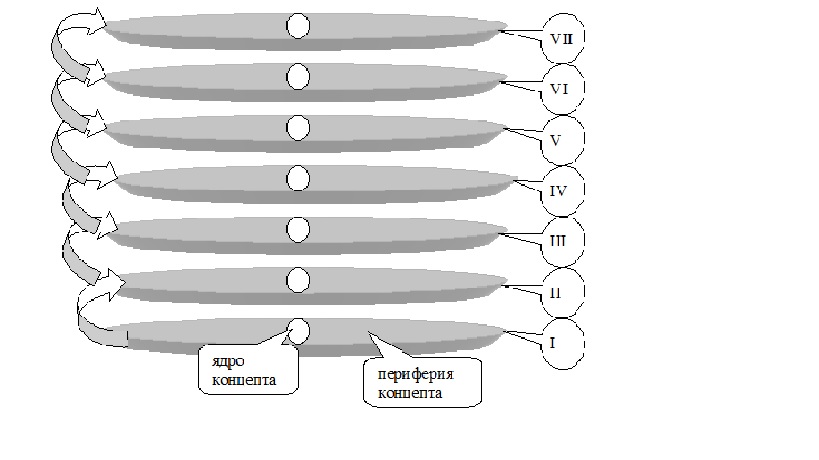Architectonics of the popular science concept-dominant “Geographical Discoveries” in the light of interpretative modeling
The article deals with the conceptual sphere architectonics of a popular science text as a set of popular science concepts in order to identify the construction specifics of this research construct. A popular science concept is understood as a research construct having a kernal-peripheral nominative field in the form of a set of markers for popular science representation of reality. The architectonics of one of the popular science concepts is modeled and interpreted. This concept is a civilisationally oriented concept-dominant “Geographical Discoveries”. The presentation of concept-dominant nominative field in the form of a graphical diachronic seven-tier kernal-peripheral model is substantiated. Based on the fact that the concept-dominant as a research construct is a unit of subconcepts, the popular science concept-dominant “Geographical Discoveries” is considered as a combination of four subconcepts: subconcept “Great Navigators”, subconcept “Great Land-Explorers”, subconcept “Expedition”, subconcept of “Open Geographical Features”. The possibility of expanding the subconcepts list as a result of subsequent studies is emphasized. Based on Internet sources in English, the nominative field of subconcept “Christopher Columbus is a great navigator” and the nominative field of subconcept “The First Voyage of Christopher Columbus” are analysed. On the material of the book in Russian about the Great Russian sailors, published in 1898, the nominative field of the subconcept “Vitus Bering is the Great Navigator” and the nominative field of the subconcept “Bering`s Expedition” are analysed. Through cognitive hermeneutic analysis, it is proved that the nominative fields of the subconcept “Christopher Columbus is the Great Navigator” and the subconcept “Vitus Bering is the Great Navigator” represent the synergy of the frame and the cognitive script. It is established that the subconcept “The First Voyage of Christopher Columbus” and the subconcept “Bering`s expedition” are implemented in the form of personalised nonlinear cognitive script in which chronemes, polarisation markers, subterminal points, and expeditionary vocabulary indicating the specifics of the expedition are identified. As a result of the research, an interpretive model of two segments of the popular science concept-dominant “Geographical discoveries” was obtained. The following terms are introduced into the scientific thesaurus: informative density of the concept`s nominative field, graphic diachronic model of the concept, sociographic marker, subterminal point, background conjugate terminal.
Figures

Ogneva, E.A. (2021). Architectonics of the popular science concept-dominant “Geographical Discoveries” in the light of interpretative modeling. Research Result. Theoretical and Applied Linguistics, V.7 (2), 78-94, DOI: 10.18413/2313-8912-2021-7-2-0-8


















While nobody left any comments to this publication.
You can be first.
Boldirev, N. N. (2009). Conceptual base of language. Cognitive studies of language, 4, 25-78. (In Russian)
Bolotnova, N. S. (2016). Philologicheskij analiz teksta [Philological analysis of text], Phlinta, Мoscow, Russia. (In Russian)
Buzina, Е. I. (2019). Lexical timers’ determination in temporal literary structure, Foreign languages: linguistic and methodological aspects, 44, 174-178. (In Russian)
Glamazda, S. N. (2019). Specific features of interpretation of social contextpolarisation markers, Research Result.Theoretical and applied linguistics, 5 (3), 23-32. (In Russian)
Danilenko, I. А. (2019). Dual concept as variety of a dual kernel literary concept, Foreign languages: linguistic and methodological aspect, 44, 183-189. (In Russian)
Dronova, L. P. (2013). Methodology of a diachronic research and a cognitive approach to language, Bulletin of Tomsk state university. Philology, 2 (22), 22-39. (In Russian)
Dronova, L. P. (2014a). Methodology of a diachronic research and a cognitive approach to language, Bulletin of Tomsk state university. Philology, 2 (28), 16-24. (In Russian)
Dronova, L. P. (2014b). Diachronic presentation of concept: to methodology of analysis, Issues of cognitive linguistics, 3 (040), 59-65. (In Russian)
Galperin, I. R. (2007). Tekst kak ob`ekt lingvisticheskogo issledovaniya [Text as a linguistic research object], Nauka, Мoscow, Russia. (In Russian)
Gasparyan, G. R. (2014). Text as a discursive event / G.R. Gasparyan, and V.E. Chernyavskaya. Issues of cognitive linguistics, 4, 44-51. (In Russian)
Isachenko, A. G. (1971). Razvitie geographicheskih idej [Development of geograpgical ideas], Mysl`, Мoscow, Russia. (In Russian)
Lotman, Yu. M. (2010). Chemu uchansya ludi (stat`i i zametki) [What do people study (articles and notes)], Rudomino, Мoscow, Russia. (In Russian)
Ljalina, М. А. (1898). Russkie moreplavateli arcticheskie i krugosvetnie. Puteshestvie V. Beringa, G. Saricheva, Ph.P. f-Vrangelja, Ph.P. Litke, A.E. Nordenshel`da, I. Ph. Kruzenshterna i Ph. Ph. Bellinsgausena [Russian navigators artic and round the world. Travellings of V. Bering, G. Sarichev, Ph.P. f-Vrangel Ph.P. Litke, A.E. Nordenshel`d, I. Ph. Kruzenshtern, and Ph. Ph. Bellinsgausen], izdanie A. Ph. Devriena, S-Peterburg, Russia. (In Russian)
Ogneva, Е. А. (2009). Kognitivnoe modelirovanie konceptospheri hudogestvennogo teksta [Cognitive modeling of the literary conceptual sphere], BelGU, Belgorod, Russia. (In Russian)
Ogneva, Е. А. (2014). Interpolative concept of text cognitive script architectonics, Research Result.Theoretical and applied linguistics, 1, 2 (2), 75-87. [Online] Available in: http://www.belsu-research-result.ru/images/stories/nom2/lingvistika.pdf (Accessed 17 September 2014). (In Russian)
Ogneva, Е. А. (2017). Popular science concept: concept and interpretation, Text. Language. Person, Моzir`, MPGU im. I.P. Shamjakina, 31-33. (In Russian)
Prokhorova, A. V. (2018). Speech representation of bipolarity in literary world view (based on the oppositional discourse of L. Andreev`s prose), Abstract of Ph.D. dissertation, 10.02.01 – Russian language, Elec, Russia. (In Russian)
Schirova, I. A. (2013). Tekst skvoz` prizmu slognogo [Text through a prism of complicated things], Politehnika-servis, S-Peterburg, Russia. (In Russian)
Сhristopher Columbus. [Online], available in: https://en.wikipedia.org/wiki/Christopher_Columbus (Accessed 10 December 2019). (In English)
Cramer, F. (2001). Digital code and literary text, Beehive Hypertext Hypermedia Literary Journal, 1-9. [Online], available in: http://www.p0es1s.net/poetics/symposion2001/a_cayley.html (Accessed 06 October 2008) (In English)
Klarer, M. (2011). An introduction to literary studies, Routledge, London and New York. (In English)
Macherey, P. (2006) A Theory of Literary production, Routledge, London. (In English)
The First Voyage of Christopher Columbus. [Online], available in: http://latinamericanhistory.about.com/od/latinamericatheconquest/p/Columbusfirst.htm (Accessed 16.11.2019). (InEnglish)